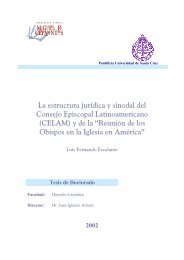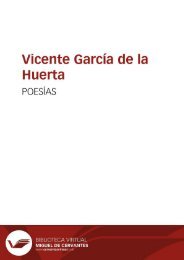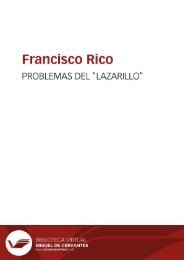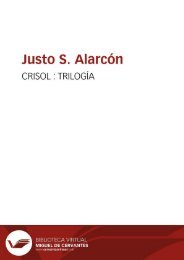Create successful ePaper yourself
Turn your PDF publications into a flip-book with our unique Google optimized e-Paper software.
Anales galdosianos [Publicaciones periódicas]. Año XII, 1977<br />
el de ésta es un sacerdote; pero las dos se enamoran después de seducidas, surge en ellas la necesidad<br />
de confesar su situación, y a partir de este momento las dos novelas toman rumbo distinto » 197<br />
. The parallel drawn by the distinguished critic may be questionable as far as some details go, but<br />
the analogy is just as to the sentimental make-up of the two characters. Both are orphans, penniless,<br />
subject to another's influence and domination -in short, victims. On one level Tristana may belong to<br />
the « viejo y la niña » tradition of farce and fabliaux, but she has none of the feminine character's<br />
mischief and picaresque traits that are its trademarks and which Cervantes, for example, imbued in<br />
his Leonarda of La cueva de Salamanca or Lorenza of El viejo celoso . (García Lorca, I might add,<br />
did similarly in our century in La zapatera prodigiosa .)<br />
Amparo is meek and frightened but she, too, yearns for a place in the sun and is aware of the injustice<br />
done to women. « ¡Ay! don Agustín », she says to her rich suitor, « dichoso el que es dueño de sí<br />
mismo, como usted. ¡En qué condición tan triste estamos las pobres mujeres que no tenemos padres,<br />
ni medios de ganar la vida, ni familia que nos ampare, ni seguridad de cosa alguna como no sea de<br />
que al fin, al fin, habrá un hoyo para enterrarnos!... Eso del monjío, qué quiere usted que le diga, al<br />
principio no me gustaba; pero va entrando poquito a poco en mi cabeza, y acabaré por decidirme...<br />
» (IV, 1476). Actually she has no more a calling for convent life than Tristana, but for both the world<br />
is a trap and a deception. In at least the first part of their respective novels they are akin to <strong>Galdós</strong>'<br />
early heroine, Clara of La fontana de oro , another orphan, penniless, cloistered and victimized. To<br />
put it briefly, all three derive, more or less , from the star-crossed heroines of the folletín .<br />
We know that <strong>Galdós</strong>' early novels have a kinship with the « novelas por entregas » and the<br />
folletín . And we also know that, like Dickens, he continued to be intrigued with the genre even<br />
later in his development as a novelist. Tormento , the work seen by Casalduero as a starting point<br />
for Tristana , is notable in this regard. Its much discussed prologue -the exchange between Felipe<br />
Centeno and Ido del Sagrario- deals with the two poles of fiction: art and artifice. Ido, working for<br />
a hack writer, is engaged in composing a melodramatic concoction which features his neighbors,<br />
the Sánchez Emperador sisters. In his opus the girls are virtuous orphans who are threatened with<br />
dishonor by a scheming Marquis -a situation very different from the version <strong>Galdós</strong> gives us, Ido<br />
seems to be aware that he is taking liberties with the truth, but he considers this evasion precisely the<br />
moral obligation of his task as writer. « Tú no entiendes de arte », he tells Felipe. « Cosas pasan<br />
estupendas que no pueden asomarse a las ventanas de un libro porque la gente se escandalizaría...<br />
197 Op. cit. , p. 104.<br />
147

















